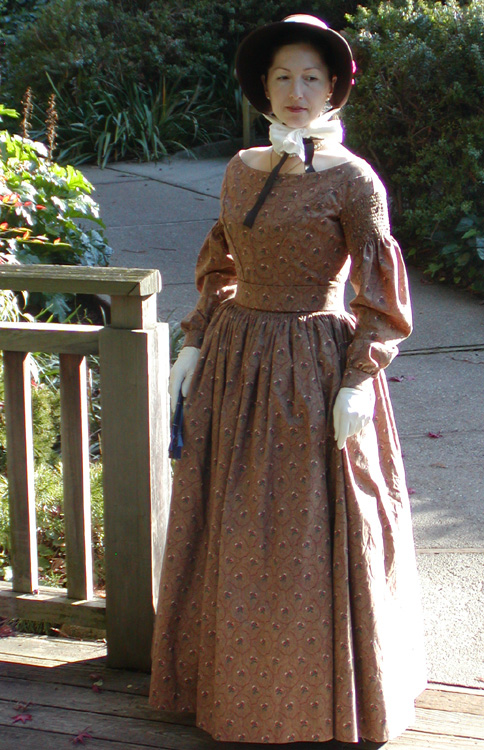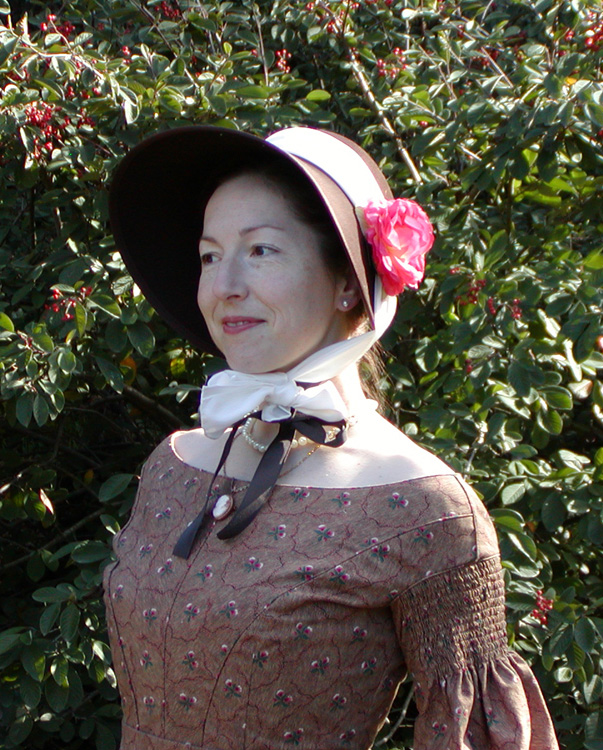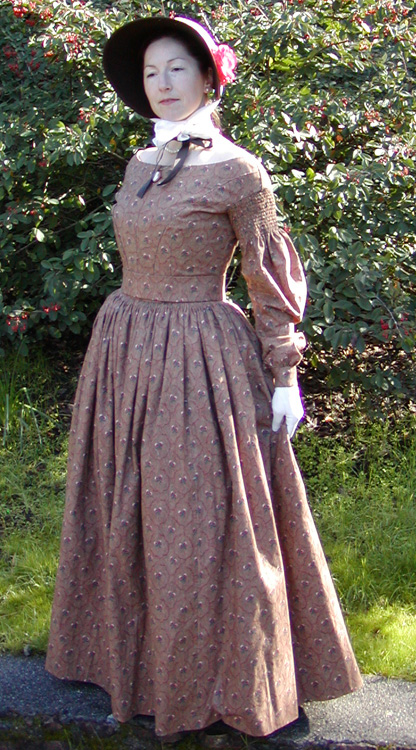
October – December 2006
This dress has fashion elements from the late-1830s to early-1840s. I made it to wear to the local Dickens Fair. To me it reads more late 1830s, because of the straight-cut waistline, open neckline, and wide belt. So that’s how I think of it.
I was able to make use of my 1830s chemise, corded petticoat, and the Victorian corset, undies and petticoat. I’m happy to say that the new 1830s chemise stayed out of sight, thanks to the drawstring neckline. The outer petticoat got one alteration: I repleated it to a longer waistband. It now sits just below my natural waist. This reduced some of the bulk from all those layers of undergarments. As an alternative, I could have shortened the bodice, but I think this is a little more flattering. And to get really obsessive about the underwear: more petticoats might be in order. I’ll just leave that for another project…
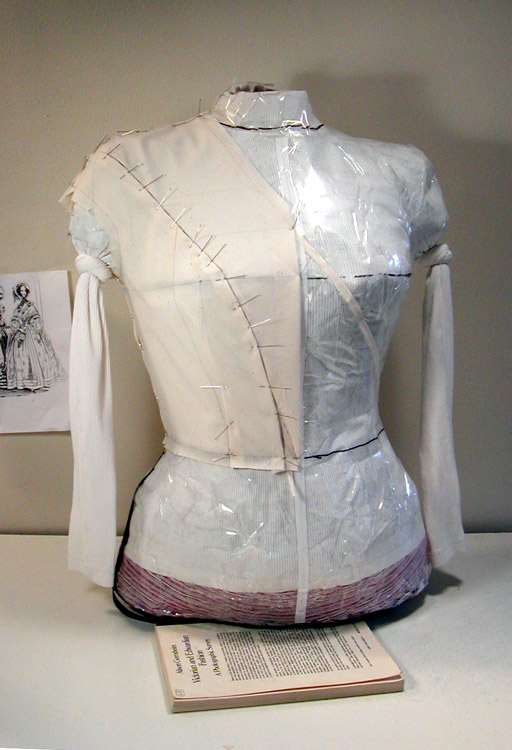
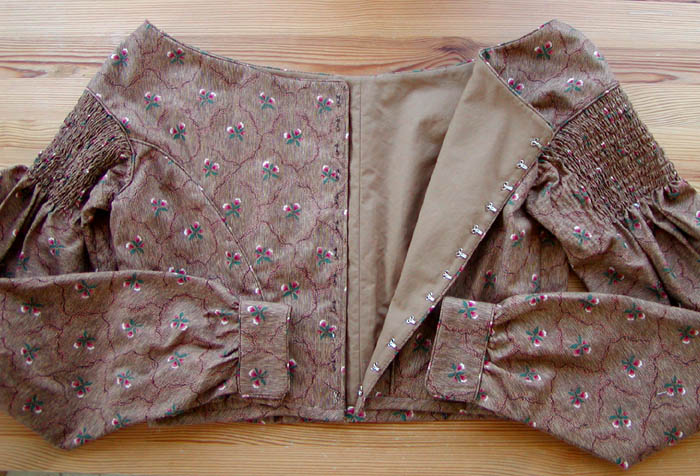
The bodice was draped on a home-made dress form. I used clear packaging tape and stuffed it with newspaper. Do not try this at home! The tape stretched out and it eventually ended up in the trash. But it was sufficient to get this one pattern.
It’s a princess-seamed bodice with a dart added to the side front. The shoulders are dropped and it has a typical Victorian, curved back seam. Center front is cut on the bias and center back closes with hook and bars. The seam placement was modeled after photos of some early 1840s dresses in Victorian and Edwardian Fashion. But there’s an 1837 example that’s quite similar on p.171 of Costume in Detail. Patterning during this era could be quite complex, as illustrated by this 1837 dress at the Met. For the rest of the costume, I copied the 1837-41 dress from Patterns of Fashion. I used the same sleeves, and the 147″ skirt width. I also made the 1/16″ mini-piping.
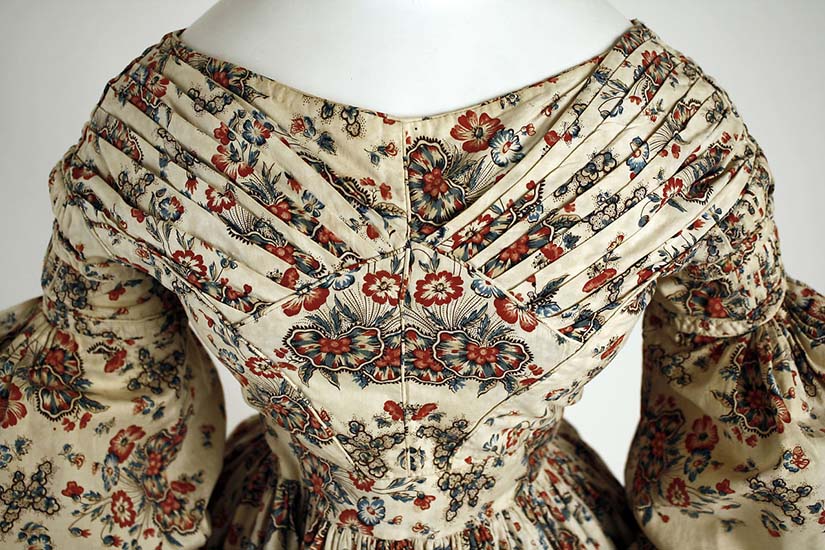
The Met, New York
And now — for my secret ingredient — the piping was made with hemp cord! (I’d been looking for an opportunity to use this stuff since reading Jennifer Thompson’s hemp cord article here). It’s stitched to the following seams: center front, side front, side back, center back, armholes, shoulders, neckline and cuffs. “Threads” magazine has a great article on piping in their Aug-Sept 05 issue. This helped enormously with the sewing.
One of my goals for this project was to make a dress that looked less “costumey.” I was trying for light, wearable and “real.” So as an experiment, I backed the bodice in cotton sateen rather than a heavier twill or duck. A few stays were added, and it was lined in the same sateen. At the time, I wasn’t sure this had been a good move: the bodice seemed awfully lightweight compared to my other Victorian projects. But I made a point of handling some late 19th Century clothing at the next antiques fair, this time focusing on the weight and feel of the fabrics, rather than just the pretty styles. I’ve since concluded that this underlining wasn’t such a bad choice after all. My bodice feels pretty similar to the garments I inspected.
The skirt is fully lined in sateen, so to avoid putting too much strain on the bodice fabric, it seemed best to cartridge pleat the skirt to a separate waistband. Hooks and bars attach the bodice to the waistband, and a separate belt goes on top. The sleeves are unlined, which keeps them nice and droopy.
This dress was originally meant to be a trial version until I found the right silk. But I ended up really liking this reproduction-style print, and am perfectly happy to call it final, in the cotton. Plus with all the piping and shirring, it would have taken at least twice as long to sew it up in silk, and I probably wouldn’t have had a new dress in time for the Fair!
Last but not least, for accessories: some vintage kid gloves, jewelry, a bonnet from Top-Hats with a silk scarf from Dharma, and that’s my favorite fan I’m holding.
